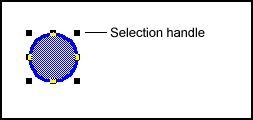FrameMaker 7.0 Tutorial: Graphics
Displaying the Tools Palette
To get started creating graphics in FrameMaker, create a new document and display the Tools palette:
- Open FrameMaker, and select File > New > Document.
- From the New dialog box, click Portrait.
- Click
 (Tools Palette) located on the right side of the document window.
(Tools Palette) located on the right side of the document window.
The tools palette contains the following tools and properties:

4. You will use the tools palette to select drawing tools and change the properties of drawing objects.
5. Select File > Save As.
6. In the File name box, type graphics, and click Save.
- Selection tools: used to select existing text and drawing objects.
- Drawing tools: used to draw shapes such as lines, arcs, rectangles, circles, and polygons.
- Drawing properties: used to view and change a drawing object’s properties.
- On the tools palette, click
 (Rectangle Tool).
(Rectangle Tool).
- Click and drag the crosshair in the document window to draw a rectangle. After you release the mouse button and move the pointer away from the rectangle, the pointer changes back to
 (I-beam).
(I-beam). - Press the Delete key to delete the rectangle.
To draw a square:
- On the tools palette, click
 (Rectangle Tool).
(Rectangle Tool).
- Press and hold the Shift key, and then drag the crosshair to create the square. (Holding the Shift key keeps the sides of the rectangle equal, allowing you to easily create a square.)
- Select Graphics > Object Properties.
- In the Object Properties dialog box, type 2 in the Width and Height boxs.
- Click Set. (This feature allows you to create objects using exact measurements.)
- Select the square from the previous exercise.
- Select Graphics > Set # Sides.
- In the Set Number of Sides dialog box, type 8 in the Number of Sides box.
- Click Set.
The square changes to an octagon.
- Draw a square. (Remember to press and hold the Shift key.)
- Click
 (oval tool), and draw a circle. (Press and hold the Shift key to draw a circle.)
(oval tool), and draw a circle. (Press and hold the Shift key to draw a circle.)
Make the circle slightly smaller than the square.
- With the circle still selected, press and hold the Shift key, and then select the square. (Both objects should be selected.)
- Select Graphics > Align.
- In the Align dialog box, select T/B Centers and L/R Centers.
- Click Align.
The center of the circle is aligned with the center of the square.
- Select the square that you created in the previous exercise.
- Position your cursor over the bottom-center selection handle until your cursor changes to
 (Arrow) .
(Arrow) .

- Click the selection handle, and drag downward a few inches to extend the square into a rectangle.
Tip: You can also resize an object to exact measurements by right-clicking the object, selecting Object Properties, and then typing exact measurement for Width and Heigth properties. - Select the circle that you created in the previous exercise.
- Place your cursor over the circle.
Your cursor changes to
 (hollow arrow).
(hollow arrow).
- Press and hold the Ctrl key, and then drag the circle downward.
Notice that
 (plus sign) is added to your cursor. This signifies that you are dragging a copy of the object instead of the original object.
(plus sign) is added to your cursor. This signifies that you are dragging a copy of the object instead of the original object. Tip: To drag the object in a straight line, press and hold the Shift key. - Repeat the steps above to create a third circle.
- Select one of the circles that you created in the previous exercise.
- Press and hold the Shift key, and then select the other two circles.
- Select Graphics > Distribute.
- In the Distribute dialog box, select Equidistant Centers for both Horizontal Spacing and Vertical Spacing.
- Click Distribute. The three circles are now distributed with equal space between them.
- Make certain that the three circles are still selected.
- Select Graphics > Group.
The three circles are now grouped together and treated as one object. The selection handles change to reflect this new grouping.
- With the group still selected, press and hold the Shift key, and then select the rectangle.
- Select Graphics > Align.
- In the Align dialog box, select T/B Centers and L/R Centers, and click Align.
The group is now centered within the rectangle.
- To ungroup the selection, select Graphics > Ungroup.
- Select the top circle.
- Click
 (Set Fill Pattern).
(Set Fill Pattern).
- In the Fill Pattern dialog box, select the solid fill option.

- Click
 (Set Color).
(Set Color).
- In the Color dialog box, select Red.

- Select the middle circle, and repeat the steps above to apply a solid, yellow fill.
- Select the lower circle, and apply a solid, green fill.
- Select the rectangle.
- Click
 (Set Line Width).
(Set Line Width).
- In the Line Width dialog box, select a thicker line weight.

- Click
 (Set Line Widths), and select a thinner line weight for the callouts.
(Set Line Widths), and select a thinner line weight for the callouts.
- Click
 (Set Color), and select the color black.
(Set Color), and select the color black.
- Click
 (Draw a Line).
(Draw a Line).
- Draw a line that extends out from the red circle.
Tip: To create a horizontal line, press and hold the Shift key. - Place your cursor over the line. (Your cursor changes to a hollow arrow.)
- Press and hold both the Ctrl and Shift keys, and then drag the line downward to the yellow circle.
- Repeat the steps above to add a line to the green circle..
- Click
 (Draw a Text Line).
(Draw a Text Line).
- Click within the document window next to the callout for the red circle.
- Type the word Red. (You can change the font and point size using the Format menu.)
- Repeat the steps above to add text to the yellow and green circles.
Note: Text lines are somewhat different than other drawing objects because you can select the object (with selection handles) or select the text characters. Experiment with the two types of selection tools to see what kind of results you get.
| Note: You use the same basic procedure to draw circles, arcs, lines, and freehand lines. |
To draw an octagon:
Selecting Objects
Before you can change a drawing object or its properties, you must first select the object. When an object is selected, selection handles appear around the object. You must click the border of the object to select it.

You can use the selection handles to resize, reshape or rotate a drawing object. For example, to rotate the octagon you just created, select the border of the octagon, press and hold the Alt key, and then drag a selection handle either clockwise or counter-clockwise.
Aligning Objects
To align objects:
Resizing Objects
To resize objects:
Duplicating Objects
To duplicate objects:
Distributing Objects
To evenly distribute objects:
Grouping Objects
To group objects:
Changing Object Properties
Using the tools palette, you can customize object properties, such as the color and type of fill within your circles and the line width of your rectangle. The left side of the tools palette contains the options for changing drawing properties, and the right side displays the current settings.

To change object properties:
Adding Callouts and Text
To add callouts and text:
In this tutorial you learned how to use the tools palette to create simple objects. Try adding arrowheads to the callouts in your drawing. Experiment with the other drawing tools and object properties.



Comments